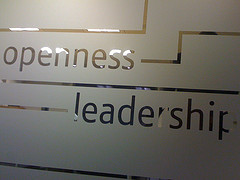|
|
|
Monday, June 15th, 2015
 First it was Uber drivers, members of the so-called 1099 economy, who sued Uber. First it was Uber drivers, members of the so-called 1099 economy, who sued Uber.
Next, the general public woke up to tech’s rapacious abuse of their privacy and personal information.
And last week nearly half of shareholders voted against the executive compensation plan of a company whose stock is near its all-time high.
According to an SEC document filed Tuesday, nearly 47% of the total shareholders voted against Salesforce’s executive compensation packages at its annual shareholders meeting…
Maybe, just maybe, corporate America has finally gone too far and we’re ready to fight back.
Flickr image credit: Annelid
Posted in Change, Compensation | No Comments »
Thursday, March 6th, 2014

Many founders talk about the desire to build truly open cultures.
Then they start adding exceptions and caveats, especially when it comes to compensation—whether dollars or stock.
Sharing compensation information is usually discouraged and discussing stock options or salary may even be considered a firing offense.
While there are startups opting for openness, what happens over time?
Based on Whole Foods nearly 30-year trial salary openness can work.
Whole Foods co-CEO John Mackey introduced the policy in 1986, just six years after he co-founded the company. In the book, he explains that his initial goal was to help employees understand why some people were paid more than others. If workers understood what types of performance and achievement earned certain people more money, he figured, perhaps they would be more motivated and successful, too.
It takes solid planning and a culture with a real commitment to transparency and developing people over time to make it work.
By making it’s financials, including profitability, available to all it employees, so they could see not just what everyone was paid, but where else the money went, Whole Foods created a true feeling of ownership along with the knowledge that promotion was available and the support to make it happen.
The company’s openness even drew recognition from the Federal Government.
In fact, in the late 1990s the widespread availability of so much detailed financial data led the SEC to classify all of the company’s 6,500 employees as “insiders,”
Building openness into your culture requires support and full buy-in from your senior staff.
And that means being willing to pass on people who have the right skills, but not the right attitude.
Flickr image credit: Paul Downey
Posted in Compensation, Entrepreneurs, Stock Options | No Comments »
Thursday, March 7th, 2013
 Interesting comments from Ben Horowitz on why firing a member of the founding team as the company grows may be both a necessary decision and an ethical one. Interesting comments from Ben Horowitz on why firing a member of the founding team as the company grows may be both a necessary decision and an ethical one.
If your current executive team helped you 10X your company, how can you dismiss them when they fall behind in running the behemoth they created? The answer is that your loyalty must go to your employees—the people who report to your executives. Your engineers, marketing people, sales people, finance and HR people who are doing the work. You owe them a world-class management team. That’s the priority.
Can’t argue that and it can happen long before the 10X level is reached.
Horowitz says during each year’s review he would spell out the changes that come with growth.
“Therefore, you will have a new and very different job and I will have to re-evaluate you on that job. If it makes you feel better, that rule goes for everyone on the team including me.”
He goes on to say,
“In giving this kind of direction, it’s important to point out to the executive that when the company doubles in size, she has a new job. This means that doing things that made her successful in her old job will not necessarily translate to success in the new job. In fact, the No. 1 way that executives fail is by continuing to do their old job rather than moving on to their new job.”
What he doesn’t say is that it’s part of the boss’ job to help any employee prepare for those expanded responsibilities;
- First, by providing insight on what improved/new skills and additional knowledge are needed to perform well in the new position, whether or not the title changes.
- Second, by suggesting resources, such as classes, training (if available) and mentoring.
This is as true for executives as it is for any other level.
It’s difficult for people to evaluate their own strengths and weaknesses in a position they know well, let alone in one they haven’t done yet.
This holds true for founders and CEOs, too, assuming they want to hold on to their positions.
However, there is one other question that should be added to the discussion that is some variation of the following, “Now that you understand what will be involved in your new responsibilities is that what you want to do? Do you feel it’s a good fit for who you are and who you want to be; in other words, will it make you happy?”
People are usually happiest in a company of a certain size and at a certain time in its life.
Joining before that or staying after is never a good idea.
Flickr image credit: WalkingGeek
Posted in Entrepreneurs, Motivation | No Comments »
Monday, May 21st, 2012
 The most recent act of executive ultra-stupidity brought down not only Brian Dunn, Best Buy’s CEO, but also Richard Schulze, its founder who was CEO for 40 years and Chairman for ten. The most recent act of executive ultra-stupidity brought down not only Brian Dunn, Best Buy’s CEO, but also Richard Schulze, its founder who was CEO for 40 years and Chairman for ten.
All over what was, according to Dunn and the 29-year-old woman subordinate, a platonic friendship, albeit one with some very tasty perks for the gal.
Schulze is out because he learned about it last December, but didn’t mention it to his board, HR or ethics officer. (Hell of a way to cap 50-plus years of amazing success.)
The report cited the effects of the relationship, including disruption in the workplace, damaged employee morale and perceived favoritism that undermined the employee’s supervisor’s attempts to manage her.
“Further, the C.E.O.’s relationship with this employee led some employees to question senior management’s commitment to company policy and the ethical principles the company champions,” the report said. “During interviews, some employees said that they felt that the rules appeared to apply to every employee except the C.E.O.,” it said.
When will they learn?
When will ‘but me’ be exorcised from executive/management thinking?
When will management learn the importance of walking their talk and that the higher the position the more important that becomes?
Three questions, but just one five-letter answer—never.
Image credit: unkown
Posted in Business info, Leadership | No Comments »
Tuesday, February 1st, 2011
 I was delighted when I read Alan Lewis’ article in HBR on why his $600 million dollar company is more interested in a cultural match than a skills match when hiring. Although the interview techniques he describes may not travel well, the necessity for a cultural match is bang on. I was delighted when I read Alan Lewis’ article in HBR on why his $600 million dollar company is more interested in a cultural match than a skills match when hiring. Although the interview techniques he describes may not travel well, the necessity for a cultural match is bang on.
As Lou Gerstner said after leading the turnaround at IBM, “Culture isn’t just one aspect of the game, it is the game.”
10 years ago I wrote an article for MSDN about how to use company culture as a screening tool to find good matches and avoid hiring turkeys of any kind that works at all levels; I’ve posted slightly updated versions on the blog every couple of years since 2006.
With hiring heating up in some sectors and still tight in others it’s more important than ever. The old management attitude of “hire, flip and replace if someone doesn’t work out” doesn’t fly well any more.
As important as cultural fit is in the ranks, it is a thousand times more important as you move up the management ladder and absolutely critical at the executive level—the higher the level of a bad cultural fit the more extensive the damage that will be done.
Don’t Hire Turkeys!
Use Your Culture as an Attraction, Screening and Retention Tool to Turkey-Proof Your Company.
Companies don’t create people—people create companies.
All companies have a culture composed of its core values and beliefs, essentially its corporate MAP (mindset, attitude, philosophy™); that culture is why people join the company and why they leave if it changes.
Generally, people don’t like bureaucracy, politics, backstabbing, etc., but when business stress goes up, or business heats up, cultural focus is often overwhelmed by other priorities.
In startups, it’s easier to hire people who are culturally compatible, because the founders first hire all their friends, and then their friend’s friends.
After that, when new positions have to be filled the only people available are strangers.
So how do you hire strangers and not lose your culture?
Since your culture is a product of your people, hire only people with matching or synergistic attitudes. The trick is to have a turkey sieve that will automatically screen out most of the misfits and turn on the candidates with the right values and attitudes.
Here is how you do it.
- Your sieve is an accurate description of your real culture.
- It must be hard copy (write it out), fully publicized (everyone needs to know, understand, believe and talk about it), and, most important of all, it must be real.
- Email it to every candidate before their interview and be sure that everyone talks about the culture during the interview and sells the company’s commitment to it.
- Everybody interviewing needs to listen carefully to what the candidate is saying and not saying; don’t expect a candidate to openly admit to behaviors that don’t fit the company MAP, since she may be unaware of them, may assume that your culture is more talk than walk or consider it something that won’t apply to her.
- Red flags must be followed up, not ignored because of skills or charm.
- Consider the various environments in which she’s worked; find out if she agreed with how things were done, and, more importantly, how she would have done them if she had been in control.
- Whether or not the candidate is a manager, you want to learn about her management MAP, approaches to managing, leadership and work function methods.
- Probing people to understand what their responses, conscious as well as intuitive, are to a variety of situations reveals how they will act, react, and contribute to your company’s culture and its success.
Finally, it is up to the hiring manager to shield the candidate from external decision pressures, e.g., friends already employed by the company, headhunters, etc.
Above all, it is necessary to give all candidates a face-saving way to withdraw their candidacy and say no to the opportunity. If they don’t have a graceful way of exiting the interview process they may pursue, receive, and accept an offer, even though they know deep down it is not a good decision.
A bad match will do major damage to the company, people’s morale, and even the candidate, so a “no” is actually a good thing.
Remember, the goal is to keep your company culture consistent and flexible as you grow. From the time you start this process, you need to consciously identify what you have, decide what you want it to be, publicize it, and use it as a sieve to be sure that everyone who joins, fits.
Use your cultural sieve uniformly at all levels all the time. If someone sneaks through, which is bound to happen occasionally, admit the error quickly and give her the opportunity to change, but if she persists then she has to go.
Do this and watch retention, creativity, productivity and morale surge ever higher.
Image credit: http://www.flickr.com/photos/zedbee/103147140/
Posted in Culture, Ducks In A Row, Hiring | 4 Comments »
Saturday, September 5th, 2009
Have you ever registered to receive McKinsey reports? It’s free (my favorite price) and it’s valuable (my favorite requirement). I like it because I choose the categories I want and am not inundated with stuff I don’t want.
 Today there are only two, because both are heavy on the meat, which requires more time and thought to digest and make use of. Today there are only two, because both are heavy on the meat, which requires more time and thought to digest and make use of.
The first is a global survey on how executives dealing with the recession as opposed to the thoughts and feelings of middle management. It makes for fascinating reading and offers up some interesting surprises.
The second discusses better ways to utilize frontline managers. “Instead of administrative work and meetings, they should focus on coaching their employees and on constantly improving quality.” Notice it says ‘instead‘, not ‘in addition to’, a not-so-subtle point that is missed by many higher level managers and executives. McKinsey also set up a discussion forum on Facebook and the author responded here.
Your comments—priceless
Don’t miss a post, subscribe via RSS or EMAIL
Image credit: nono farahshila on flickr
Posted in About Leadership, management, Seize Your Leadership Day | No Comments »
Tuesday, November 4th, 2008
By Wes Ball. Wes is a strategic innovation consultant and author of The Alpha Factor – a revolutionary new look at what really creates market dominance and self-sustaining success (Westlyn Publishing, 2008) and writes for Leadership turn every Tuesday. See all his posts here. Wes can be reached at www.ballgroup.com.
 Are leaders and managers getting dumber or is it just who is assessing them? Are leaders and managers getting dumber or is it just who is assessing them?
Wally Bock’s Three Star Leadership blog led me to a very interesting post by Ken Nowack concerning the discrepancies between self-perception of performance and external assessment for corporate executives. The point of the article was that, as managers move up the corporate ladder, they seem to gain more and more blindness to their real performance.
The “no-clue gene,” as Nowack put it, crosses gender boundaries, but “does seem to be more pronounced as leaders move up the corporate hierarchy.”
Any of us who have worked in the corporate world know what he’s talking about. And the worst part is that most corporate employees look at the top-most levels of their company and fear that the person at the very top may be one of the clueless ones.
I have seen this at work across all size companies from the largest in their category down to mid-sized regional companies. Smaller companies are not immune, but there the faults of a leader are far more apparent to everyone involved, including the leader himself.
Ignoring the obvious and all too typical problem of employees naively believing that they could certainly do better at their manager’s simple job, even though they really don’t see what he or she actually does, I have seen three factors that drive such disconnects for managers between self-perception and the perceptions of those around them:
- Corporate pressures on managers/leaders and internal competitiveness are immense these days, and they create a self-defensiveness that increases significantly as one moves up the corporate ladder. This pressure creates stress that actually does reduce performance aptitude, while it also creates a greater self-protective need to justify oneself. Honestly, who would want a top-executive job in most large corporations these days, no matter what the payout looked to be?
- The demands upon top leaders are so great that they themselves don’t believe they are up to the challenge, so they compensate with apparently extreme conceit. This is a most natural reaction among most personality types to any self-perception of weakness. Among driver personalities it can be a positive self-motivator – they have learned that, if you think of yourself as something better, you can become it, so they use this tool to drive themselves to greater performance. Among other personality types, this compensation usually backfires.
- Most leaders have bought into the belief that they must be able to walk on water in order to lead an organization or team. It’s the old military code that a leader never admits ignorance; he just states his opinion with greater confidence. That is a formula for failure in the corporate world, if I’ve ever seen one. No one can stand up for long to that kind of expectation. Yet, when faced with the reality of personal weakness, many positional leaders just can’t or won’t face that truth.
I wrote a post a few months ago supporting Jeffery Immelt of GE, who had just been whipped public ally by his ex-boss, Jack Welch, for not being a clairvoyant about profit in their tumultuous financial services group. I’m not a big fan of Immelt, but the pressure he was under to perform with perfection in an imperfect environment demonstrates what many top leaders are up against.
This problem only decreases in scope and intensity, as you go down the corporate ladder.
- There far too many persons ready and willing to throw someone else under the bus when they spot any weakness that can be exploited.
- I can’t even guess how many times I’ve heard corporate employees say that they can’t trust anyone.
- The loneliness of business that used to only exist at the top tiers has sifted downstairs throughout the corporate ranks.
- The fad of 360-degree assessments has only fueled such isolation, because everyone around you suddenly becomes a potential critic who will be heard.
There is certainly incompetence evident in most organizations. I would suggest, however, that the perceptions of incompetence are often anything but objective, and the causes for the real managerial and leadership weaknesses seen could be addressed through a better model for expectations for leadership and how to assess performance.
When was the last time you trusted a co-worker who could assess your performance?
When was the last time you saw someone in your organization admit weakness?
I had a unique view of this through the 15 years of research I did into dominant companies for my book The Alpha Factor. I saw it at an even closer level as we conducted the tests with more than 75 companies to see if our findings could create dramatic, sustainable growth.
One of the interesting things I discovered was that there was little direct correlation between ability of a company to create such sustainable growth and the actual competence of top leadership.
Rather, it was the willingness of top leadership to allow the smart, very competent people below them to do smart things that had a far greater correlation than the leader’s personal aptitude.
I recall being more than a bit skeptical about the conclusions of Jim Collins’ book, Good to Great, where his team had decided that leadership approach was the critical factor in defining great companies vs. simply good ones.
Your comments—priceless
Don’t miss a post, subscribe via RSS or EMAIL
Image credit: flickr
Posted in About Leadership, Change, Entrepreneurship, Leading Stupidities, management, Wes Ball | 1 Comment »
Friday, July 14th, 2006
Whether you’re the CEO of a Fortune 100 or the owner of a small biz you need a senior staff. “Senior staff” doesn’t necessarily mean a bunch of vice presidents (although, for convenience, I’m going to use that title in this post), but it does mean the top people in your company who manage different functions (with or without staff). They are the people the CEO relies on
- as a sounding board;
- for both tactical and strategic intelligence;
- to tell it like it is—even when he doesn’t want to hear it
- to see and understand the big picture;
- to lead the effort in employee acquisition, motivation, and retention;
- to support and strengthen the culture she envisioned;
- to not sabotage another group or start a turf war, and
- to help stamp out politics whenever and wherever it rears its ugly head.
And more, but you get the idea.
The first item on your agenda when creating a senior staff is to determine what parts of your business/company (beyond the standard ones of finance, development, marketing, and sales) need to report directly to the CEO for peak performance. You never want function that is truly critical to our success reporting through, and responsible to, someone else, because personal agendas can get in the way.
It may be customer service (or whatever it’s called); it could be IT; if you are large enough to have a real HR department (not just a benefits admin) it should definitely report directly. Support functions are often left to report to the CFO, which can prevent them from being used fro real strategic advantage.
Where does one find talented VPs? Now and then you’ll be lucky enough to actually hire one complete with all the bells and whistles, but more likely you will find a current VP, or talented director, with some of them, or with the right potential.
Be aware that one of the main things that sets good VPs apart from other managers is a strong strategic ability, that means they see the entire team and understand how their department fits into the whole. I’ve known many C-level executives who never grasp this, as well as director level (and lower) managers who get it.
All of your staff needs a real understanding of business, including financials, and it’s your responsibility, as their manager, to make sure that they get whatever training and information is needed to do their job as a member of your senior staff.
Further, if you want the most powerful senior staff possible cross train them in each others functions and challenges. Think of the phenomenal value of a CFO who understands the intricacies of manufacturing as more than a set of numbers; a VP of Engineering who understands financials and inventory turns; an HR head who understands what actually happens in the different departments, etc.
Think of the power inherent in a senior staff that understands what it takes to turn an idea into a product and a product into revenue.
Think of what a difference it would make to your ability to do your own job.
Posted in Business info, Communication, Culture, Hiring, Retention | No Comments »
|
 Subscribe to
Subscribe to
MAPping Company Success
About Miki 
Clarify your exec summary, website, etc.
Have a quick question or just want to chat? Feel free to write or call me at 360.335.8054
The 12 Ingredients of a Fillable Req
CheatSheet for InterviewERS
CheatSheet for InterviewEEs™
Give your mind a rest. Here are 4 quick ways to get rid of kinks, break a logjam or juice your creativity!
Creative mousing
Bubblewrap!
Animal innovation
Brain teaser
The latest disaster is here at home; donate to the East Coast recovery efforts now!
Text REDCROSS to 90999 to make a $10 donation or call 00.733.2767. $10 really really does make a difference and you'll never miss it.
And always donate what you can whenever you can
The following accept cash and in-kind donations: Doctors Without Borders, UNICEF, Red Cross, World Food Program, Save the Children
*/
?>About Miki
About KG
Clarify your exec summary, website, marketing collateral, etc.
Have a question or just want to chat @ no cost? Feel free to write
Download useful assistance now.
Entrepreneurs face difficulties that are hard for most people to imagine, let alone understand. You can find anonymous help and connections that do understand at 7 cups of tea.
Crises never end.
$10 really does make a difference and you’ll never miss it,
while $10 a month has exponential power.
Always donate what you can whenever you can.
The following accept cash and in-kind donations:
|
 First it was Uber drivers, members of the so-called 1099 economy, who sued Uber.
First it was Uber drivers, members of the so-called 1099 economy, who sued Uber.





 The most
The most I was delighted when I read
I was delighted when I read  Today there are only two, because both are heavy on the meat, which requires more time and thought to digest and make use of.
Today there are only two, because both are heavy on the meat, which requires more time and thought to digest and make use of. Are leaders and managers getting dumber or is it just who is assessing them?
Are leaders and managers getting dumber or is it just who is assessing them?
